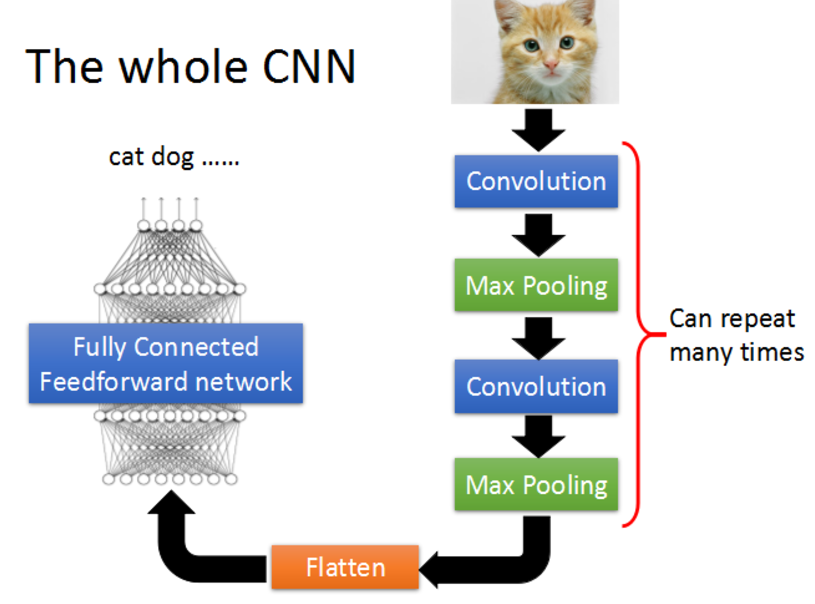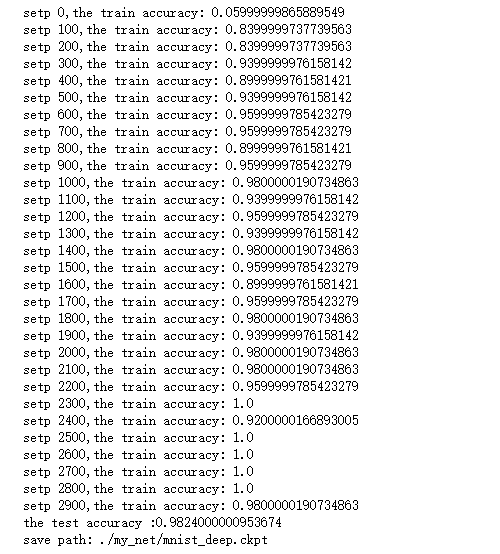TensorFlow实现CNN
TensorFlow是目前深度学习最流行的框架,很有学习的必要,下面我们就来实际动手,使用TensorFlow搭建一个简单的CNN,来对经典的mnist数据集进行数字识别。
如果对CNN还不是很熟悉的朋友,可以参考:Convolutional Neural Network。

下面就开始。
step 0 导入TensorFlow
import tensorflow as tf
from tensorflow.examples.tutorials.mnist import input_data
step 1 加载数据集mnist
声明两个placeholder,用于存储神经网络的输入,输入包括image和label。这里加载的image是(784,)的shape。
mnist = input_data.read_data_sets('MNIST_data/', one_hot=True)
x = tf.placeholder(tf.float32,[None, 784])
y_ = tf.placeholder(tf.float32, [None, 10])
step 2 定义weights和bias
为了使代码整洁,这里把weight和bias的初始化封装成函数。
#----Weight Initialization---#
#One should generally initialize weights with a small amount of noise for symmetry breaking, and to prevent 0 gradients
def weight_variable(shape):
initial = tf.truncated_normal(shape, stddev=0.1)
return tf.Variable(initial)
def bias_variable(shape):
initial = tf.constant(0.1, shape=shape)
return tf.Variable(initial)
step 3 定义卷积层和maxpooling
同样,为了代码的整洁,将卷积层和maxpooling封装起来。padding=‘SAME’表示使用padding,不改变图片的大小。
#Convolution and Pooling
#Our convolutions uses a stride of one and are zero padded so that the output is the same size as the input.
#Our pooling is plain old max pooling over 2x2 blocks
def conv2d(x, W):
return tf.nn.conv2d(x, W, strides=[1,1,1,1], padding='SAME')
def max_pool_2x2(x):
return tf.nn.max_pool(x, ksize=[1,2,2,1], strides=[1,2,2,1], padding='SAME')
step 4 reshape image数据
为了神经网络的layer可以使用image数据,我们要将其转化成4d的tensor: (Number, width, height, channels)
#To apply the layer, we first reshape x to a 4d tensor, with the second and third dimensions corresponding to image width and height,
#and the final dimension corresponding to the number of color channels.
x_image = tf.reshape(x, [-1,28,28,1])
下面我们就要开始搭建CNN结构了。
step 5 搭建第一个卷积层
使用32个5x5的filter,然后通过maxpooling。
#----first convolution layer----#
#he convolution will compute 32 features for each 5x5 patch. Its weight tensor will have a shape of [5, 5, 1, 32].
#The first two dimensions are the patch size,
#the next is the number of input channels, and the last is the number of output channels.
W_conv1 = weight_variable([5,5,1,32]) #We will also have a bias vector with a component for each output channel.
b_conv1 = bias_variable([32]) #We then convolve x_image with the weight tensor, add the bias, apply the ReLU function, and finally max pool.
#The max_pool_2x2 method will reduce the image size to 14x14.
h_conv1 = tf.nn.relu(conv2d(x_image, W_conv1) + b_conv1)
h_pool1 = max_pool_2x2(h_conv1)
step 6 第二层卷积
使用64个5x5的filter。
#----second convolution layer----#
#The second layer will have 64 features for each 5x5 patch and input size 32.
W_conv2 = weight_variable([5,5,32,64])
b_conv2 = bias_variable([64]) h_conv2 = tf.nn.relu(conv2d(h_pool1, W_conv2) + b_conv2)
h_pool2 = max_pool_2x2(h_conv2)
step 7 构建全链接层
需要将上一层的输出,展开成1d的神经层。
#----fully connected layer----#
#Now that the image size has been reduced to 7x7, we add a fully-connected layer with 1024 neurons to allow processing on the entire image
W_fc1 = weight_variable([7*7*64, 1024])
b_fc1 = bias_variable([1024]) h_pool2_flat = tf.reshape(h_pool2, [-1, 7*7*64])
h_fc1 = tf.nn.relu(tf.matmul(h_pool2_flat,W_fc1) + b_fc1)
step 8 添加Dropout
加入Dropout层,可以防止过拟合问题。注意,这里使用了另外一个placeholder,可以控制在训练和预测时是否使用Dropout。
#-----dropout------#
#To reduce overfitting, we will apply dropout before the readout layer.
#We create a placeholder for the probability that a neuron's output is kept during dropout.
#This allows us to turn dropout on during training, and turn it off during testing.
keep_prob = tf.placeholder(tf.float32)
h_fc1_dropout = tf.nn.dropout(h_fc1, keep_prob)
step 9 输入层
没有什么特别的,就是输出一个线性结果。
#----read out layer----#
W_fc2 = weight_variable([1024,10])
b_fc2 = bias_variable([10])
y_conv = tf.matmul(h_fc1_dropout, W_fc2) + b_fc2
step 10 训练和评估
首先,需要指定一个cost function --cross_entropy,在输出层使用softmax。然后指定optimizer--adam。需要特别指出的是,一定要记得
tf.global_variables_initializer().run()初始化变量
#------train and evaluate----#
cross_entropy = tf.reduce_mean(tf.nn.softmax_cross_entropy_with_logits(labels=y_, logits=y_conv))
train_step = tf.train.AdamOptimizer(1e-4).minimize(cross_entropy)
accuracy = tf.reduce_mean(tf.cast(tf.equal(tf.argmax(y_, 1), tf.argmax(y_conv, 1)), tf.float32))
with tf.Session() as sess:
tf.global_variables_initializer().run()
for i in range(3000):
batch = mnist.train.next_batch(50)
if i % 100 == 0:
train_accuracy = accuracy.eval(feed_dict = {x: batch[0],
y_: batch[1],
keep_prob: 1.})
print('setp {},the train accuracy: {}'.format(i, train_accuracy))
train_step.run(feed_dict = {x: batch[0], y_: batch[1], keep_prob: 0.5})
test_accuracy = accuracy.eval(feed_dict = {x: mnist.test.images, y_: mnist.test.labels, keep_prob: 1.})
print('the test accuracy :{}'.format(test_accuracy))
saver = tf.train.Saver()
path = saver.save(sess, './my_net/mnist_deep.ckpt')
print('save path: {}'.format(path))
这是我训练的结果。

reference:
https://www.tensorflow.org/get_started/mnist/pros
TensorFlow实现CNN的更多相关文章
- FaceRank-人脸打分基于 TensorFlow 的 CNN 模型
FaceRank-人脸打分基于 TensorFlow 的 CNN 模型 隐私 因为隐私问题,训练图片集并不提供,稍微可能会放一些卡通图片. 数据集 130张 128*128 张网络图片,图片名: 1- ...
- Tensorflow简单CNN实现
觉得有用的话,欢迎一起讨论相互学习~Follow Me 少说废话多写代码~ """转换图像数据格式时需要将它们的颜色空间变为灰度空间,将图像尺寸修改为同一尺寸,并将标签依 ...
- Tensorflow的CNN教程解析
之前的博客我们已经对RNN模型有了个粗略的了解.作为一个时序性模型,RNN的强大不需要我在这里重复了.今天,让我们来看看除了RNN外另一个特殊的,同时也是广为人知的强大的神经网络模型,即CNN模型.今 ...
- [DL学习笔记]从人工神经网络到卷积神经网络_3_使用tensorflow搭建CNN来分类not_MNIST数据(有一些问题)
3:用tensorflow搭个神经网络出来 为什么用tensorflow呢,应为谷歌是亲爹啊,虽然有些人说caffe更适合图像啊mxnet效率更高等等,但爸爸就是爸爸,Android都能那么火,一个道 ...
- 第三节,TensorFlow 使用CNN实现手写数字识别(卷积函数tf.nn.convd介绍)
上一节,我们已经讲解了使用全连接网络实现手写数字识别,其正确率大概能达到98%,这一节我们使用卷积神经网络来实现手写数字识别, 其准确率可以超过99%,程序主要包括以下几块内容 [1]: 导入数据,即 ...
- [Tensorflow] Cookbook - CNN
Convolutional Neural Networks (CNNs) are responsible for the major breakthroughs in image recognitio ...
- 6 TensorFlow实现cnn识别手写数字
------------------------------------ 写在开头:此文参照莫烦python教程(墙裂推荐!!!) ---------------------------------- ...
- tensorflow构建CNN模型时的常用接口函数
(1)tf.nn.max_pool()函数 解释: tf.nn.max_pool(value, ksize, strides, padding, data_format='NHWC', name=No ...
- 用 Tensorflow 建立 CNN
稍稍乱入的CNN,本文依然是学习周莫烦视频的笔记. 还有 google 在 udacity 上的 CNN 教程. CNN(Convolutional Neural Networks) 卷积神经网络简单 ...
随机推荐
- SQLServer中Partition By
http://www.cnblogs.com/vincentonline/p/4999225.html 今天群里看到一个问题,在这里概述下:查询出不同分类下的最新记录.一看这不是很简单的么,要分类那就 ...
- 《从零开始学Swift》学习笔记(Day 58)—— Swift编码规范之变量或常量声明规范
原创文章,欢迎转载.转载请注明:关东升的博客 声明是在声明变量.常量.属性.方法或函数和自定义类型时候需要遵守的规范. 首先变量或常量时每行声明变量或常量的数量推荐一行一个,因为这样以利于写注释.示例 ...
- mybatis的dao的注解
import com.jianwu.domain.metting.model.CallPreMember;import com.jianwu.domain.metting.model.CallPreM ...
- svn 插件去除已经保存的密码方法
删除掉C:\Documents and Settings\hao\Application Data\Subversion\auth\svn.simple文件夹下的文件即可. 再次访问时,会弹出要求输入 ...
- angular下如何绑定form表单的change事件
ng-change = "formChange()" 不起作用 应该改为: onchanged = "angular.element(this).scope().form ...
- JavaScript 学习(1)--window对象
JavaScript 学习--Window对象 window对象方法 1.1 创建新窗体 //窗体打开 var newWindow=Window.open("default.html&quo ...
- 查看python对象的属性
在Python语言中,有些库在使用时,在网络上找到的文档不全,这就需要查看相应的Python对象是否包含需要的函数或常量.下面介绍一下,如何查看Python对象中包含哪些属性,如成员函数.变量等,其中 ...
- Java 之网络编程
网络模型 OSI 模型, 把网络通信的工作分为七层. TCP/IP 模型, 把网络通信的工作分为四层 应用层 传输层 网际层 主机至网络层 网络通信要素 (java.net 包) - IP 地址 (I ...
- VS c++ opencv画图
任务:用c++在图片上画线 之前用过python的opencv,所以直接想到了用c++的opencv来画线. 但关键就是VS中如何配置c++ opencv库的问题: vs中opencv库的配置:htt ...
- Go语言版本的helloworld
新建一个project,然后建立一个main目录,在main目录下新建一个go类文件:main.go 内容如下: package main import "fmt" func ma ...
